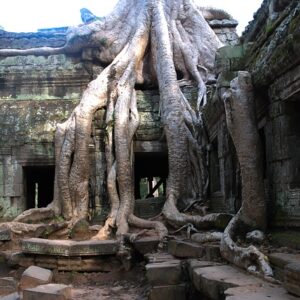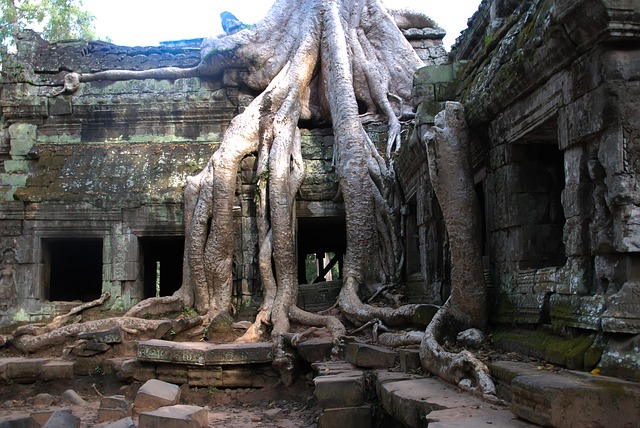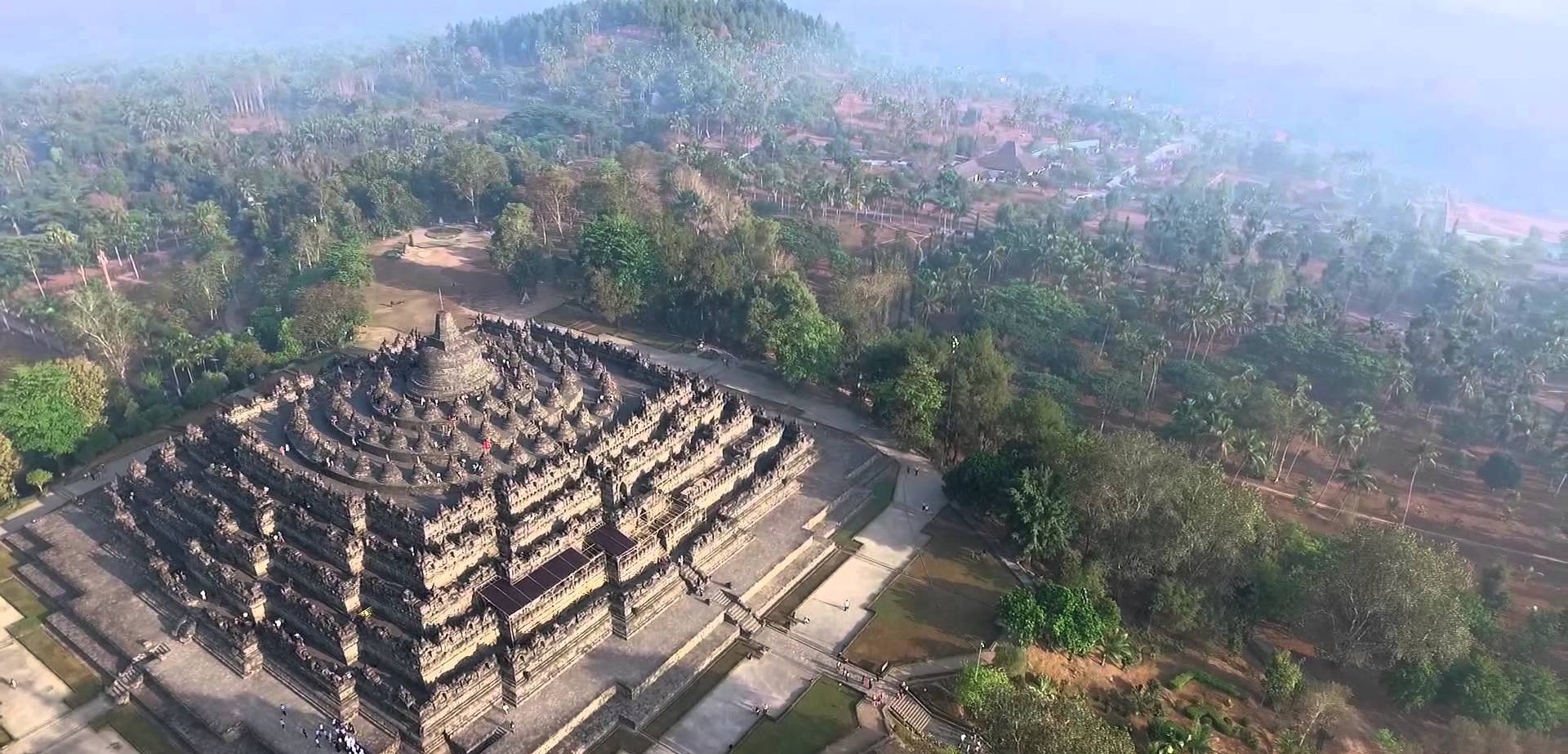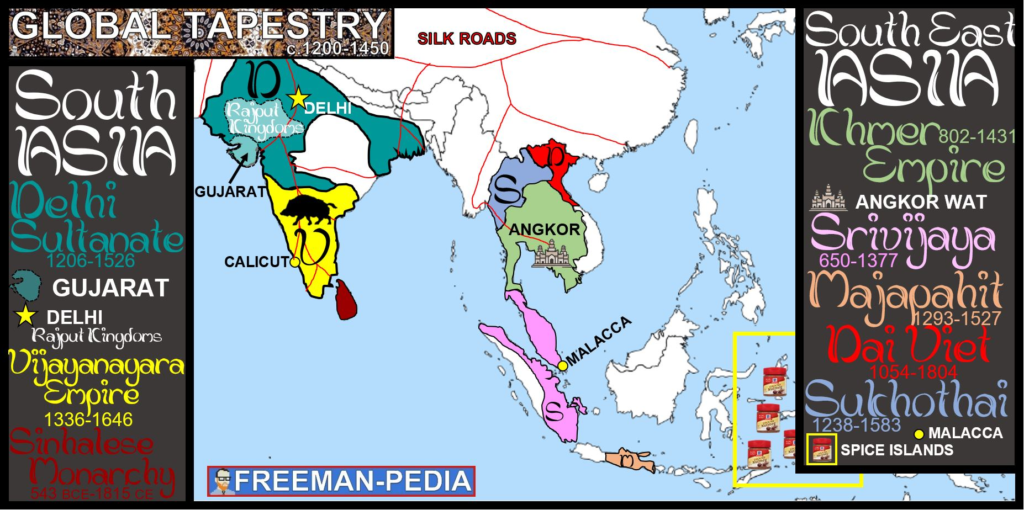
Welcome to The Global Tapestry of South & SouthEast Day
>Learning Areas
| Unit 2: The Global Tapestry (Population Patterns and Processes) |
| How states formed, expanded, and declined in areas of the world during the period c. 1200–c. 1450 |
| Patterns associated with human populations. |
| Population density and how it affects society and the environment |
| Theories of population growth and decline |
| Population and immigration policies and their effects |
Session One: Introduction
South Asia broadly includes the modern day regions and countries of: India, Pakistan, Sri Lanka, and Bangladesh.
SouthEast Asia broadly includes the modern day regions and countries of: Indonesia, Malaysia, Thailand, Laos, Vietnam, Cambodia, and Singapore.
South Asia is the birthplace of four of the world’s religions: Hinduism, Buddhism, Sikhism, and Jainism. Three that come from West Asia: Christianity, Islam, and Judaism arrived later. Zoroastrianism, the major religion in ancient Persia (now Iran) until it became Muslim, also survives in India.
The bodies of water in these regions (routes of trade) include: The Indian Ocean (Bay of Bengal), Gulf of Thailand, South China Sea, Andaman Sea, and Java Sea.
Activity ONE – Quizlet
Session Two: South Asia
Delhi Sultanate (Northern India and Pakistan)

The Delhi Sultanate or the Sultanate of Delhi was a late medieval empire primarily based in Delhi that stretched over large parts of the Indian subcontinent, for 320 years (1206–1526).
Following the invasion of South Asia by the Ghurid dynasty, five dynasties ruled over the Delhi Sultanate sequentially: the Mamluk dynasty (1206–1290), the Khalji dynasty (1290–1320), the Tughlaq dynasty (1320–1414), the Sayyid dynasty (1414–1451), and the Lodi dynasty (1451–1526).

It covered large swaths of territory in modern-day India, Pakistan, and Bangladesh as well as some parts of southern Nepal.
(From: https://en.wikipedia.org/wiki/Delhi_Sultanate)
This first video spans a longer period than 1200 to 1450 AD but gives a good and sound overview of the region around that time.
Gujarat (Western India)
Gujarat is a state along the western coast of India. Its coastline of about 1,600 km (990 mi) is the longest in the country, most of which lies on the Kathiawar peninsula.
Gujarat is the fifth-largest Indian state by area, covering some 196,024 km2 (75,685 sq mi); and the ninth-most populous state, with a population of 60.4 million in 2011. It is bordered by Rajasthan to the northeast, Dadra and Nagar Haveli and Daman and Diu to the south, Maharashtra to the southeast, Madhya Pradesh to the east, and the Arabian Sea and the Pakistani province of Sindh to the west. Gujarat’s capital city is Gandhinagar, while its largest city is Ahmedabad. The Gujaratis are indigenous to the state and their language, Gujarati, is the state’s official language.
(From: https://en.wikipedia.org/wiki/Gujarat)
From 1297 to 1300, Alauddin Khalji, the Turkic Sultan of Delhi, destroyed Anhilwara and incorporated Gujarat into the Delhi Sultanate. After Timur’s sacking of Delhi at the end of the 14th century weakened the Sultanate, Gujarat’s governor Zafar Khan Muzaffar asserted his independence and established the Gujarat Sultanate; his son, Sultan Ahmad Shah I (ruled 1411 to 1442), restructured Ahmedabad as the capital.
(From: https://en.wikipedia.org/wiki/History_of_Gujarat)
Origin of the Vijayanagar Empire (Southern India)
The Vijayanagara Empire, also known as the Karnata Kingdom or Vijayanagara Samrajya, was established in 1336 CE on the southern banks of river Tungabhadra in the present state of Karnataka in India. The Capital of the Vijayanagara Empire was the city of Hampi (currently in Karnataka).
Hampi is declared a World Heritage Site by UNESCO. Geographically, it lies close to the Deccan Plateau of South India. The founder of the Vijayanagara Empire was the brothers Harihara and Bukka, belonging to the Sangama Dynasty. Harihara and Bukka were members of a pastoralist cowherd community that claimed to be of the Kuruba lineage. Both Harihara and Bukka had also served under the Hoysala King, Vira Ballala III. The Vijayanagara period was the golden age of literature in South India.
(From: https://testbook.com/ias-preparation/the-vijayanagar-empire)
Sinhalese Monarchy (Sri Lanka)
The history of Sri Lanka is unique because the relevance and richness of it extends beyond the areas of South Asia, Southeast Asia and the Indian Ocean. The early human remains which were found on the island of Sri Lanka date back to about 38,000 years ago (Balangoda Man).
The historical period roughly begins in the 3rd century CE. They describe the history of Sri Lanka since the arrival of Prince Vijaya who was from Northern India. The Kingdom of Tambapanni as established in the 6th century BCE by the earliest ancestors of the Sinhalese.
The first Sri Lankan ruler of the Anuradhapura Kingdom, Pandukabhaya, is recorded for the 4th century BCE. Buddhism was introduced in the 3rd century BCE by Arhath Mahinda (son of the Indian emperor Ashoka).
(From: https://en.wikipedia.org/wiki/Sultan)
The Sinhalese monarchy (Sinhala) has its origins in the settlement of North Indian Indo-Aryan immigrants to the island of Sri Lanka. The Landing of Vijay as described in the traditional chronicles of the island, the Dipavamsa, Mahavamsa and Culavamsa.
Dīpavaṁsa - an extract
[The Chronicle of the Island]
Adoration to the venerable, holy, universal Sambuddha.
I. Buddha’s subjection of the Yakkhas
1. I will set forth the history of Buddha’s coming to the Island,
of the arrival of the relic and of the Bo (branch), of the doctrine of
the teachers who made the recensions (of Dhamma and Vinaya), of
the propagation of the Faith in the Island, of the arrival of the chief
of men (Vijaya); listen.
2. Listen attentively to (the history proclaimed by) me, which
inspires joy and delight, which causes serenity and gladdens the
mind, which comprises many various forms.
3. With elated minds, satisfied, delighted and joyful, attentively
receive the faultless, auspicious discourse.
4. Listen all, giving your minds (to the subject); I will proclaim a
history, handed down from generation to generation, highly praised,
adorned in many ways, joined together in this (work), just as flowers
of various kinds (form a garland).
5. Attend to this incomparable praise of the Island (Ceylon), which
dwells upon the most excellent successions (of teachers and kings),
which is new and unrivalled and well narrated, which has been
handed down by Saints, which is praised by all good men and
revered by the holy ones.
Tamerlane
Timur or Tamerlane (8 April 1336 – 17–19 February 1405) was a Turco-Mongol conqueror who founded the Timurid Empire in and around modern-day Afghanistan, Iran, and Central Asia, becoming the first ruler of the Timurid dynasty. An undefeated commander, he is widely regarded as one of the greatest military leaders and tacticians in history, as well as one of the most brutal and deadly. Timur is also considered a great patron of art and architecture as he interacted with intellectuals such as Ibn Khaldun, Hafez, and Hafiz-i Abru and his reign introduced the Timurid Renaissance.
(From: https://en.wikipedia.org/wiki/Timur)
Activity TWO – Google My Maps – Use Google My Maps or similar or the map outline below (you could use the printout to plan and make notes too) to create a map to show the regions of South Asia (1200 to 1450 AD).
Suggested list of regions / cities for the map: (Example)
- Gujahat (Western India)
- Delhi Sultanate (Northern India and Pakistan)
- Birthplace of Amir Khurso
- Tale of 4 Dervishes
- Ibn Battuta’s 7 years as a judge in the Delhi Sultanate
- Vijayanayara Empire (Southern India)
- Sinhalese Monarchy (Sri Lanka)
- Delhi (India’s capital)
Session Three: SouthEast Asia
Dai Viet (Northern Vietnam)
Vietnam, officially the Socialist Republic of Vietnam (SRV), is a country at the eastern edge of mainland Southeast Asia, with an area of about 331,000 square kilometres (128,000 sq mi) and a population of over 100 million, making it the world’s fifteenth-most populous country. Vietnam shares land borders with China to the north, and Laos and Cambodia to the west. It shares maritime borders with Thailand through the Gulf of Thailand, and the Philippines, Indonesia, and Malaysia through the South China Sea. Its capital is Hanoi and its largest city is Ho Chi Minh City (commonly referred to by its former name, Saigon).
(From: https://en.wikipedia.org/wiki/Vietnam)
Đại Việt, often known as Annam, was a monarchy in eastern Mainland Southeast Asia from the 10th century AD to the early 19th century, centered around the region of present-day Hanoi, Northern Vietnam. Its early name, Đại Cồ Việt, was established in 968 by Vietnamese ruler Đinh Bộ Lĩnh after he ended the Anarchy of the 12 Warlords, until the beginning of the reign of Lý Thánh Tông (r. 1054–1072), the third emperor of the Lý dynasty. Đại Việt lasted until the reign of Gia Long (r. 1802–1820), the first emperor of the Nguyễn dynasty, when the name was changed to Việt Nam.
(From: https://en.wikipedia.org/wiki/%C4%90%E1%BA%A1i_Vi%E1%BB%87t)
Khmer Empire (Thailand, Cambodia, Vietnam, Laos)
The Khmer people are an Austroasiatic ethnic group native to Cambodia. They comprise over 95% of Cambodia’s population of 17 million. They speak the Khmer language, which is part of the larger Austroasiatic-language family alongside Mon and Vietnamese.
The majority of the world’s Khmers live in Cambodia.
There are also significant Khmer populations native to Thailand and Vietnam. In Thailand, there are over one million Khmers. Estimates for the number of the Khmers in Vietnam vary from the 1.3 million to 7 million. The Khmer population native to Laos is less significant than in Thailand and Vietnam.
(From: https://en.wikipedia.org/wiki/Khmer_people)
The Khmer Empire was a Hindu-Buddhist empire in Southeast Asia, centered around hydraulic cities in what is now northern Cambodia. Known as Kambuja by its inhabitants, it grew out of the former civilisation of Chenla and lasted from 802 to 1431. Historians call this period of Cambodian history the Angkor period, after the empire’s most well-known capital, Angkor. The Khmer Empire ruled or vassalised most of mainland Southeast Asia and stretched as far north as southern China. At its peak, the Empire was larger than the Byzantine Empire, which existed around the same time.
(From: https://en.wikipedia.org/wiki/Khmer_Empire)
Majapahit – Java, Indonesia
Majapahit was one of the last major Hindu-Buddhist empires of the region and is considered to be one of the greatest and most powerful empires in the history of Indonesia and Southeast Asia. It is sometimes seen as the precedent for Indonesia’s modern boundaries.
(From: https://en.wikipedia.org/wiki/Majapahit)
The Spice Islands (Moluccas)
(From: https://library.princeton.edu/visual_materials/maps/websites/pacific/spice-islands/spice-islands-maps.html)
The Maluku Islands or the Moluccas are an archipelago in the eastern part of Indonesia.
The islands were known as the Spice Islands because of the nutmeg, mace, and cloves that were exclusively found there, the presence of which sparked European colonial interests in the 16th century.
Sukothai (Northern Thailand & Northern Laos)

In the Sukhothai Kingdom, the monarch used the title Pho Khun, and monarchs who reigned over the period of decline after Ram Khamhaeng the Great used the title Phaya.
Malacca, Malaysia
Melaka, town and port, Peninsular (West) Malaysia, on the Strait of Malacca, at the mouth of the sluggish Melaka River. The city was founded about 1400, when Paramesvara, the ruler of Tumasik (now Singapore), fled from the forces of the Javanese kingdom of Majapahit and found refuge at the site, then a small fishing village. There he founded a Malay kingdom, the kings of which—aided by the Chinese—extended their power over the peninsula.

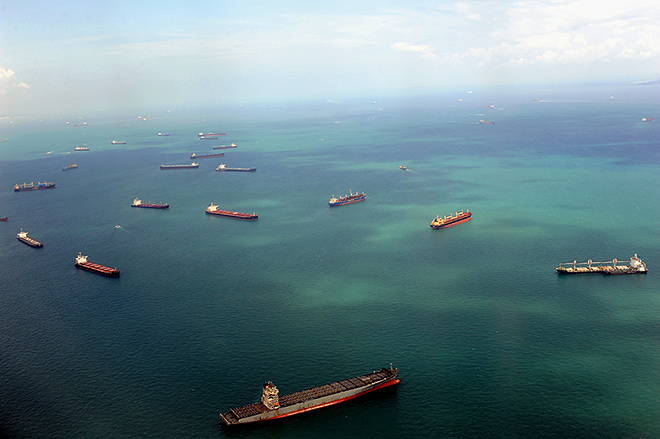
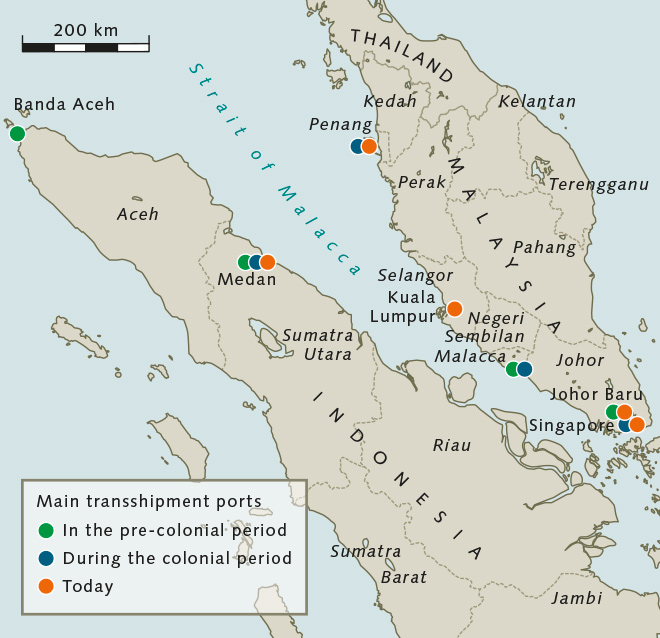
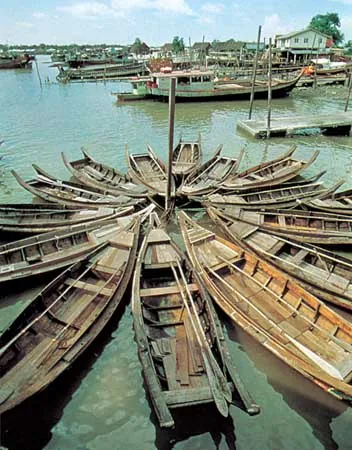
The port became a major stopping place for traders to replenish their food supplies and obtain fresh water from the hill springs. Malay rule ended in 1511, when Alfonso d’Albuquerque, viceroy of the Portuguese Indies, conquered Malacca.
(From: https://www.britannica.com/place/Melaka-Malaysia)
Srivijava (Malaysia and Sumatra, Indonesia)

Srivijaya empire, maritime and commercial kingdom that flourished between the 7th and the 13th centuries, largely in what is now Indonesia. The kingdom originated in Palembang on the island of Sumatra and soon extended its influence and controlled the Strait of Malacca. Srivijaya’s power was based on its control of international sea trade. It established trade relations not only with the states in the Malay Archipelago but also with China and India.
(From: https://www.britannica.com/place/Srivijaya-empire)
Activity THREE – Google My Maps – Use Google My Maps or similar or the map outline below (you could use the printout to plan and make notes too) to create a map to show the regions of SouthEast Asia (1200 to 1450 AD).
Suggested list of regions / cities for the map:
- Khmer Empire, (Thailand, Cambodia, Vietnam, Laos)
- Angkor Wat
- Majapahit (Java, Indonesia)
- Dai Viet (Northern Vietnam)
- Sukhothai (Northern Thailand & Northern Laos)
- Malacca (Malaysian State)
- Spice Islands (Moluccas)
- Sulalatus Salatin
- Srivijaya (Malaysia and Sumatra, Indonesia)
Session Four: The Tapestry
This is the trading network of this period; the network the Europeans (Columbus and friends) are trying to reach after 1450. Mostly peaceful exchange of goods have taken place here for millennia.
Mapping The Region
If you had landed in Venice during the mid-15th century, you might have been accosted by a monk with a prominent nose and baggy, smurf-like hat. Ignoring your exhaustion and atrocious body odor after a long sea journey, he would have dragged you to a nearby tavern and cross-examined you about your travels. What was the weather like? What kind of precious gems were mined? What animals did you encounter, and how many heads did they have?

The monk was Fra Mauro, a 15th-century version of Google Earth. Famous for his cartographic skills, he had been commissioned by King Alfonso of Portugal to produce a map of the world.
(From: https://www.atlasobscura.com/articles/fra-mauro-map)
Indian Ocean Trade
The Indian Ocean trade routes connected Southeast Asia, India, Arabia, and East Africa.

The Indian Ocean Trade began with small trading settlements around 800 A.D., and ended in the 1500s when Portugal invaded and tried to run the trade for its own profit.
As trade intensified between Africa and Asia, powerful city-states flourished along the eastern coast of Africa. These included Kilwa, Sofala, Mombasa, Malindi, and others. The city-states traded with inland kingdoms like Great Zimbabwe to obtain gold, ivory, and iron. These materials were then sold to places like India, Southeast Asia, and China. These were Africaʼs exports in the Indian Ocean Trade. These items could be sold at a profit because they were scarce in Asian countries.
(From: https://www.bu.edu/africa/files/2011/11/Indian-Ocean-Trade.pdf)
Zheng He
In the 15th century, Admiral Zheng He, on the orders of the Emperor of China, embarked upon a series of extraordinary voyages of exploration.
Zheng He was a Chinese mariner, explorer, diplomat, fleet admiral, and court eunuch during the early Ming dynasty often regarded as the greatest admiral in Chinese history. He was originally born as Ma He in a Muslim family and later adopted the surname Zheng conferred by the Yongle Emperor.
(from: https://en.wikipedia.org/wiki/Zheng_He)
Activity FOUR: Networks of Exchange
Use the videos from this session to map out trade routes and voyages pertinent to the region at the time studied. Here are some places, terms, and items of trade you could include on your map (along with anything else mentioned in the videos).
Here are some other sources that may help:
SouthEast Asia Trade Route Map
Portuguese Spanish Trade Routes
- Dhows and junks
- Large ships involved in maritime trade in Indian Ocean
- Indian port cities –called emporias
- Were clearinghouses of trade, cosmopolitan centers
- Trade goods
- Silk and porcelain from China
- Spices from southeast Asia
- Pepper, gems, pearls, and cotton from India
- Incense and horses from Arabia and southwest Asia
- Gold, ivory, and slaves from east Africa
- Rice, wood were only staple goods traded
- Specialized production
- Production of high-quality cotton textiles thrived
- Sugar, leather, stone, carpets, iron and steel
Quiz
South & South-East Asia – True or False?
